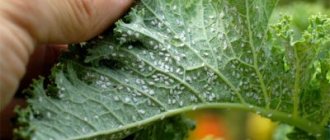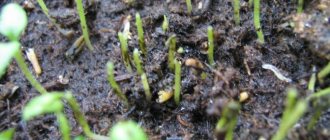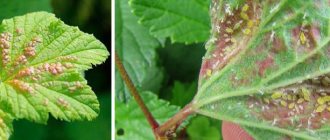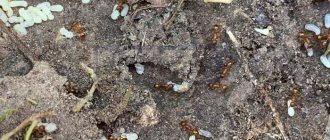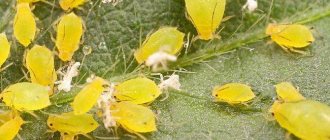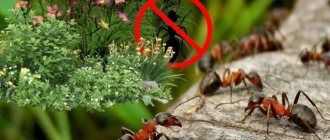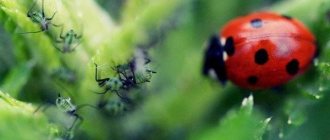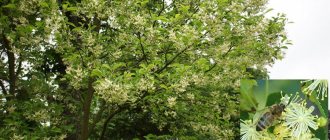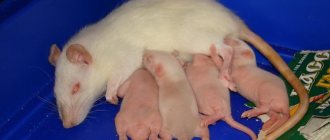Tobacco thrips is not only a major pest of tobacco - it also damages vegetable crops such as onions, cucumbers or potatoes. In addition, it transmits viral diseases, which makes this insect a very dangerous pest for crops.
Unfortunately, tobacco thrips are not the only type of thrips that are not averse to feasting on our harvest. For example, wheat thrips can cause great damage to cereal crops.
Who is tobacco thrips?
Tobacco thrips is a tiny insect that is a pest of tobacco, lily, pumpkin, melon and vegetable crops.
Thrips damages approximately 400 plant species and is distributed throughout almost the entire territory of Russia.
Description of the larva
The tobacco thrips larva resembles the adult, but without wings. Its color changes depending on the stage of maturation from white to yellow.
Description of the adult
An adult thrips has a narrow, oval body that is approximately 0.8–0.9 mm long. It has two pairs of narrow gray-yellow wings surrounded by fringe. Females and males have some differences.
The female can be either light yellow or dark, almost black, brown. It has a transverse head with small setae and a transverse prothorax. The forewings are slightly yellowish, and the lower legs and thighs are grey. The male is smaller than the female, approximately 0.1–0.3 mm. The antennae are darker, and the body, on the contrary, is lighter.
The tobacco thrips differs from other species of thrips in that it has four distal setae on the fore wings and an almost transparent first antennal segment.
Subspecies of tobacco thrips differ in body color. Dark ones are usually found in spring, and light ones in summer.
In the greenhouse
You can fight thrips in greenhouses with the help of biological preparations, for example, Thripol-L. To increase its effectiveness, it will be necessary to increase daylight hours to 14 hours. If this is not possible, then introducing a predatory bug (or other entomophages) into greenhouse structures is more effective only from April to September.
Using glue or pheromone traps will help reduce the number of adults. It is important to know that the latter option is effective in catching males. Their use must be combined with the simultaneous placement of glue traps.
Reproduction method
For the winter, females go into the soil or plant debris to a depth of 5–7 cm and emerge in mid- or late April, colonizing weeds. They lay eggs in the leaf tissue, about 100 eggs per
life. Fertility depends on the type of food plant and temperature. The most intensive development occurs in arid places.
Tobacco thrips is almost never found on young or aging leaves. Most of them are located on the formed ones. The larvae are found on the lower part of the leaf, less often on flowers or fruits.
The embryo develops from three days to a week, then passes through the larval stage for about 10 days. They go into the soil. And after about another week, adult insects rise to the surface.
Females and their offspring fly from weeds to crops and cause damage.
On cucumbers
You can detect the first signs of thrips damage to cucumbers using a magnifying glass. On the upper side of the leaf blades you can see small silvery dots, and on the lower side you can see larvae or adults. They are easily distinguished from other pests by their two pairs of fringed wings. If they are disturbed, they begin to make sharp jumps, pushing off the surface with their abdomen.
When using folk remedies such as infusion of tobacco or garlic, you will have to carry out treatments every 7 days. Better results can be achieved by treating cucumber plantings with chemicals, for example, “Alatar”. To do this, dilute 5 ml of the drug in 1 liter of water, stir, bring the volume to 5 liters and spray the cucumber bed. This working solution is enough to treat plantings on an area of 1 sq.m.
What harm does it cause to plants?
Tobacco thrips harms onions, cucumbers, zucchini, eggplant, melons, and sometimes cabbage, celery and parsley. Damage is caused by both larvae and adults.
Tobacco thrips sucks the juice from the leaves, which leads to moisture deficiency and the formation of yellow-brown spots. Petals and stamens are also damaged. When there is a high density of insects, the leaves curl, turn yellow and dry out completely. In addition, thrips can feed on the sap of flowers, causing them to fall off prematurely.
The striped click beetle larva is the most “voracious” stage of the insect’s life cycle. To get rid of the Swedish fly, you can use various control methods - both chemical and folk. You will find detailed information in this article.
Pea weevil larvae are about 6 mm in size. Read the full description of the insect at the link.
Precautionary measures
Despite the fact that tobacco infusion against pests is non-toxic, you should adhere to some safety measures
Since careless use can cause health problems, you must:
- wear a cotton-gauze bandage to protect the respiratory tract;
- rubber gloves are used to protect the skin of the hands;
- eye protection glasses;
- If the drug gets on the skin and mucous membranes of the eyes or mouth, rinse thoroughly under running water.
- while carrying out work to get rid of pests, you must not smoke, drink or eat food;
- at the end of the procedure, wash your hands and face well with soap;
- Children, pregnant and lactating women, as well as people with allergies are not allowed to work with the infusion;
- preparations of dried raw materials for the drug must be done with gloves and scissors;
- store the prepared raw materials with signed labels, because not only fresh tobacco is used to make the infusion, but also dried tobacco;
- The dishes used for making the infusion must be washed with a solution of soda ash or wood ash, and then rinsed with plain water.
Thanks to tobacco infusion, you can get rid of almost any harmful insect for home crops
It is important that this method is not only effective, but also economical
How to deal with the pest?
Consider the following pest control measures:
- agrotechnical,
- biological,
- chemical.
Agrotechnical methods
- ensuring high air humidity and uniform watering, since tobacco thrips mainly develops on those crops that grow in dry places;
- digging up the soil and eliminating post-harvest residues;
- weed control, as thrips reproduce and feed on them in the spring;
- placing onions as far as possible from other crops to prevent them from being colonized by tobacco thrips, since it is onions that are most often damaged by this pest.
Biological methods
- Predatory phytoseiid mites (Neoseyulus) effectively fight thrips larvae. The application rate is 300–500 females per plant. They are bred on wheat bran and fed with cancer mites;
- orius bugs and anthocoris bugs.
Chemicals
Insecticides are applied at weekly intervals. Cannot be used on onions grown for greens. The following remedies are effective:
- "Aktara", VDG (400 g/ha);
- "Karate Zeon", MKS (150–200 ml/ha);
- “Fufanon” (1 ampoule per 1 liter of water);
- "Commander Maxi" (3 g/ha);
- "Iskra Zolotaya" (10 ml/ha).
You can also use an infusion of onion peels - 4 liters of water per 2 liters of peels, after two days add another 12 liters of water and add laundry soap. Before storing the bulbs, they should be treated with sulfur gas (50 g of sulfur is used per 1 m3 of room).
The use of these methods (separately or in combination) will help rid tobacco and vegetable crops of tobacco thrips, and the use of uninfected planting materials will reduce the risk of its occurrence in the future.
Prevention
If you do not buy soil for planting flowers in a store, but dig it yourself, for example, from the same garden, it must be disinfected; to do this, treat it with such agents as “Antonem-F” or “Nemabakt”. Do not forget that plants need to be watered periodically so that the soil does not stand dry, and also carry out loosening.
Purchased flowers or those brought from the garden can also be carriers of these pests, so place them away from indoor plants.
To repel parasites from plants both in the garden and in the apartment, you can use strong-smelling flowers. For home flowers, you can prepare an infusion from plants such as celandine, marigold, and tobacco. And in the area in the garden where you notice the appearance of these insects, simply plant the same plants; they will help not only in the fight against thrips, but also with many other pests, for example, ants.
Prevent occurrence
Bulb plantings after thrips infection
- Onion thrips can be controlled by proper crop rotation. Repeated planting of bulbs is allowed in the same beds only after a four-year break.
- Regularly inspect plants for migrating thrips larvae. If they are detected, inspect the crops growing in the vicinity of the onion beds.
- There is no need for a greenhouse to plant cucumber seedlings and tomatoes with onions at an early stage.
- After harvesting, leave a clean garden in winter, removing and burning plant debris. The same is done with waste remaining in storage facilities after winter.
- Autumn digging of the soil to a depth of at least 0.15-0.25 m is required. This is due to the fact that the pest mainly overwinters at a depth of 7 cm.
- If onions are grown in greenhouses, after collecting the bulbs they are treated with Karbofos (15%).
- Weeding between rows in the summer, on the one hand, removes weeds, and on the other, destroys insect pupae.
- Before planting the affected seed, it is warmed up for 48 hours at a temperature of 40-42°C.
- You can immediately soak the bulbs in hot (50°C) water for 5 minutes before planting them in the ground and immediately dip them in cold water.
- Plantings of onions and other plants are regularly irrigated with water.
- If an insect has settled on an onion, you can wash it off with a stream of water under pressure.
- Mulching the soil will help maintain moisture.
Attention! Finding out whether there are thrips on onions is quite easy. You need to trudge the plant over a clean white sheet.
Onion root mite
This pest damages a lot of plants, primarily bulbs of onions, garlic, tulips, daffodils, and other bulbous plants, as well as corms of gladioli, root tubers of dahlias and many other crops.
First of all, the onion mite settles in damaged or diseased plants. The mite is moisture-loving and in humid, warm (26-28ºС) storage conditions it develops very rapidly in just 10 days.
The female mite has a broad oval, whitish vitreous body, only about 1 mm long, with brown legs and mouthparts. She can lay from 350 to 800 eggs.
The mite penetrates the bulb through the bottom and, when feeding, wears it down so much that the bottom turns into dust.
They also damage the primordia of peduncles and leaves, thereby greatly reducing the quality of planting material.
By planting mite-infested bulbs in the garden bed, we facilitate its further spread to undamaged plants.
And it is very difficult to notice these tiny pests, unless, of course, they have already seriously damaged the planting material.
Onion root mite spreads with the remains of damaged plants, soil and equipment.
Preventive measures
Simple steps that need to be performed regularly will help you avoid infection. These measures are universal (suitable for garden, garden, and home plants):
- daily thorough inspection of all parts;
- timely removal of dust, organic residues, fallen leaves and flowers;
- control the level of humidity (avoid drying out, especially in winter).
Thrips are a small pest that poses a threat to any plants. Indoor flowers, seasonal crops, garden trees - the parasite settles on any of them. Thrips feed on cell sap and carry dangerous diseases. In the absence of timely assistance, the infected plant dies. With “massive” populations of thrips, the entire crop or the entire collection of indoor flowers is at risk.
